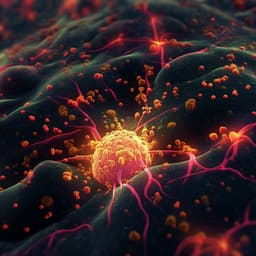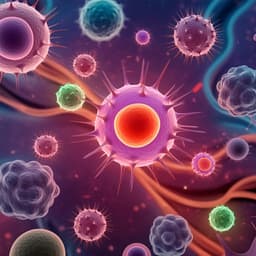
Medicine and Health
Extreme transport of light in spheroids of tumor cells
D. Pierangeli, G. Perini, et al.
This groundbreaking research by Davide Pierangeli and colleagues unveils the intriguing phenomenon of optical rogue waves in tumor-cell spheroids. Utilizing randomly modulated laser beams, they reveal localized optical modes that could revolutionize light-activated therapies by delivering concentrated optical power deep within tissue.
Playback language: English
Introduction
Rogue waves (RWs), intense and unexpected wave packets, are observed across various complex systems, including oceans, plasmas, and optical media. Their ability to transport and localize energy in disordered systems makes them potentially valuable for applications. In optics, RWs are particularly promising for probing and manipulating materials due to their robustness and noise resistance. Localizing significant optical power is crucial, especially in biomedical applications; however, extremely intense beams have not been observed in biological systems until now. This study investigates the potential of RWs in biological aggregates, focusing on tumor-cell spheroids as a model system. The highly scattering and absorbing nature of biological tissues makes light penetration challenging. The hypothesis is that RWs, as noise-resistant and localized wave packets, can overcome this limitation and act as sources of intense light spots for probing, activating, and manipulating biochemical content deep within these tissues. The potential impact of this research lies in the development of novel biomedical applications, such as light-activated therapies. The novelty lies in the exploration of a largely unexplored field: the behavior of optical extreme waves in living biomatter, particularly in the context of overcoming the challenges of light penetration in deep tissues. This research aims to demonstrate the existence and potential applications of optical RWs in a complex biological system, specifically three-dimensional tumor models, advancing the understanding of light propagation in dense biological aggregates and opening avenues for novel therapeutic strategies.
Literature Review
Existing literature demonstrates the presence of rogue waves across diverse fields. Oceanographic studies have extensively documented rogue waves in the ocean, characterizing their unpredictable occurrences and catastrophic potential. Similarly, observations in plasmas and laser systems have highlighted the emergence of extreme wave events. Theoretical studies have explored various physical mechanisms responsible for RW formation, encompassing chaos, turbulence, wave scattering, and topological effects. The interplay and unification of these processes remain active areas of research, with investigations exploring their dependence on microscopic system properties and potential exploitation in applications like neuromorphic computing. However, the formation of RWs in biological structures was previously unreported, representing a significant gap in knowledge that this study addresses. Previous studies on light propagation in biological tissues have mainly focused on the challenges posed by scattering and absorption, addressing methods to enhance light penetration and focusing. The lack of investigation into the potential role of extreme wave phenomena in biological systems forms the basis for this research.
Methodology
This study employs bioprinted three-dimensional tumor models (3DTMs) fabricated from human pancreatic cells as a surrogate for studying light propagation in tumors. These 3DTMs, representing a densely packed cell network, are illuminated with a spatially modulated laser beam at λ = 532 nm. A phase-only spatial light modulator (SLM) is used to randomly shape the incoming wavefront, creating a diverse spectrum of wavevectors. The transmitted light is imaged using a CMOS camera, allowing for detailed analysis of the intensity distribution. The experimental setup is designed to control parameters such as input power, beam size, and coupling geometry. Measurements of transmitted intensity are collected for a range of input powers, and the statistical properties of the transmitted field are analyzed. The probability density function (PDF) of the intensity is fitted to a Weibull distribution to identify the presence of RWs and analyze their dependence on input power and beam size. The Euler Characteristics (EC) of the amplitude field are calculated and compared with theoretical models for linear and nonlinear wave surfaces to confirm the nonlinear nature of the observed RWs. Transmission matrix (TM) measurements are performed to study the transmission eigenchannels and identify high-transmission modes associated with RWs. Finally, the potential for photothermal therapy is explored by analyzing the local temperature increase induced by RWs in the presence of nanoparticles, which convert light into heat. The experimental procedure involves acquiring multiple intensity distributions for different random phase masks at various input powers, beam sizes, and focusing conditions. The data analysis includes statistical analysis of intensity distributions, fitting to Weibull distribution, Euler characteristic calculation, transmission matrix reconstruction, and eigenchannel analysis. The experimental setup includes a laser source, spatial light modulator, sample holder, objective lens, and CMOS camera. The study also includes details on the cultivation and bioprinting of 3DTMs, their growth monitoring, and their characterization using microscopy.
Key Findings
The study's key findings demonstrate the existence of optical rogue waves (RWs) within three-dimensional tumor models (3DTMs) bioprinted from human pancreatic cells. The transmitted light intensity displays a heavy-tailed Weibull distribution, deviating significantly from the Rayleigh distribution expected for diffusive light transport. The Weibull parameters (shape γ and scale λ) reveal a distinct power-dependent behavior, with strong RWs emerging within a specific power range (20–70 mW). The analysis of the RWs' evolution with changing input power indicates a nonlinear origin, showing the RWs behaving as self-interacting wave packets whose maximum intensity varies non-monotonically with the incoming power. The spatial distribution of intense events further supports the nonlinear nature of the RWs, with localized modes exceeding twice the significant intensity, unlike the randomly distributed spots expected in the absence of nonlinear interactions. The Euler characteristic analysis confirms the nonlinearity of the wave surfaces, aligning with nonlinear wave models. The dependence of RW formation on the spatial features of the input beam is also observed, with RWs emerging under strong coupling conditions (larger input beam size). The transmission matrix measurements reveal the existence of high-transmission channels associated with the RWs, indicating that these RWs constitute localized waveguiding channels. The ability to control RWs is demonstrated by targeting specific input wavenumbers that excite RWs in the first transmission eigenchannel. The study concludes by demonstrating the potential of these RWs for photothermal therapy, showing that intense RWs can induce significant local temperature increases exceeding 10 °C, potentially enabling targeted treatment of deep tissues. The findings show that these RWs are robust against chemotherapy treatment (Gemcitabine), suggesting their potential for applications even in drug-resistant cancers.
Discussion
The observation of optical rogue waves in 3DTMs provides compelling evidence for nonlinear optical phenomena playing a significant role in light propagation within complex biological tissues. The Weibull distribution characterizing the intensity statistics suggests a departure from simple diffusive transport, highlighting the importance of nonlinear interactions in shaping the light field. The strong dependence of RW formation on input power and beam size indicates that the generation of these extreme events is not a random process but is rather driven by nonlinear mechanisms, possibly related to light-induced thermal effects and structural deformations within the cell network. The discovery of high-transmission channels associated with RWs has significant implications for light delivery in deep tissues, suggesting potential for bypassing the limitations of scattering and absorption encountered in conventional optical therapies. The ability to control the formation and propagation of RWs opens exciting possibilities for targeted light-based therapies, including photothermal therapy, where the localized heating provided by RWs could be used to selectively damage cancerous cells.
Conclusion
This study demonstrates for the first time the existence of optical rogue waves in three-dimensional tumor models. These nonlinear extreme events facilitate the efficient delivery of high-intensity light deep within dense biological tissue. The findings suggest potential applications in light-activated therapies, particularly photothermal therapy, enabling targeted treatment of deep-seated tumors. Future research could investigate the dependence of RW properties on various factors including cell type, tissue density, and the presence of different therapeutic agents. Further exploration of the underlying mechanisms driving RW formation and the optimization of light delivery strategies using RWs is warranted.
Limitations
The study focused on a specific type of cancer cells (human pancreatic cells) and a particular experimental setup. The generalizability of the findings to other cell types and cancer models requires further investigation. The thermal model used for evaluating temperature increases is a simplified one, neglecting convection and assuming uniform heat conductivity. More sophisticated models could provide a more accurate estimate of temperature changes. The study mainly considered the average behavior of several random phase masks. Studying the specific behavior of individual phase masks could lead to a better understanding of individual RW events. The study did not directly investigate the underlying mechanism for RW generation inside the 3DTM.
Related Publications
Explore these studies to deepen your understanding of the subject.







